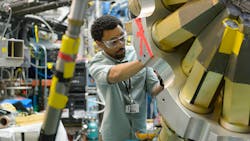Bryce Smith’s career in science began in his parents’ basement where, as a grade-schooler, he would spend his afternoons building elaborate model rollercoasters.
“I loved being able to work with my hands, to encounter problems and to find a way around them,” Smith said. “That’s what started this whole process.”
Smith spent the summer of 2018 as an intern at the U.S. Department of Energy’s (DOE) Argonne National Laboratory working in the Physics division with the Technical Support Group, helping to update hardware and software for the Gammasphere experiment at the Argonne Tandem Linear Accelerator System (ATLAS), a DOE Office of Science User Facility for nuclear physics research.
But this wasn’t Smith’s first experience with the national laboratory system. He’s been participating in DOE-sponsored programs for several years, starting when he was a sophomore at Metea Valley High School in Aurora (May through August 2012). It was then that he applied for a competitive internship at DOE’s Fermi National Accelerator Laboratory through the TARGET Program. At Fermilab, Smith worked with Arden Warner (SC Linac Department) in Fermilab’s Accelerator division.
The experience shaped his life.
“It was mind-blowing,” Smith said of the laboratory. “I was in awe. I couldn’t completely comprehend what they were doing with particle physics but I was intrigued by all of the hardware on site and by the ingenuity it took to build these complex machines. I wanted to know more.”
Smith spent his senior year of high school learning about the scientific method through his participation in the Afro-Academic, Cultural, Technological and Scientific Olympics (ACT-SO) High School Research Program, designed to recruit, stimulate and encourage high academic and cultural achievement among African-American youth.
The renowned program allowed Smith to spend a year dissecting the mathematics behind the Rubik’s cube under the guidance of Argonne researchers. He received two gold medals for his work.
“This helped me gain confidence in my scientific abilities as I started the process of becoming an engineer,” Smith said. “It was encouraging to have this early win.”
It was a victory for the national laboratories as well.
“When Argonne started the partnership in 2013 with the DuPage County ACT-SO Chapter, we had a clear vision of how our nine-month high school research program would build a strong, resilient science, technology, engineering, and mathematics pipeline of confident, college-ready, high-achieving African American youth—eventually culminating in supportive college internships at Argonne and other DOE national labs,” said Maria Curry-Nkansah, chief operations officer of Argonne’s Physical Sciences and Engineering directorate. “Bryce is living proof that this approach works.”
In his most recent national laboratory experience at ATLAS, Smith contributed to the Gammasphere experiment, which detects gamma rays emitted from atomic nuclei as they spin and cool after nuclear reactions. These reactions occur in the ATLAS facility, which accelerates particle beams into targets of selected materials; they are used to study both the origins of heavy elements and models of stellar processes from nuclear astrophysics.
“The more we know about these reactions, the better our understanding of nuclear structure,” said Smith, who began his graduate studies at Carnegie Mellon last fall. “The work we did last summer will improve the results we gather from this type of experimentation.”

